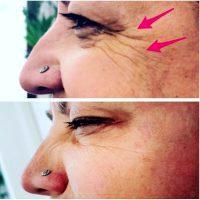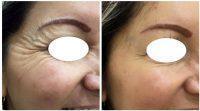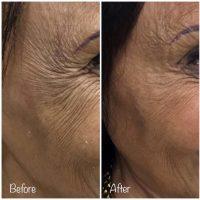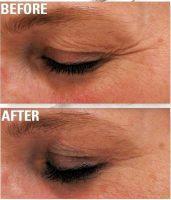Fat Or Botox Injection For Crows Feet
Crows feet are caused by the dynamic motion of the orbicularis muscle. The best way to diminish them is with a neurotoxin such as Botox.
As far as fillers or fat is concerned they can be done anytime before or after Botox and will be somewhat effect , Especially if they are done after the Botox has stopped the creation of the fine lines. (Mark T. Boschert, MD, Saint Louis Plastic Surgeon)
Fat injection will not correct the crows feet and in fact injection in this area could damage the nerves supplying the eyelid muscles and cause a paralysis.
Botox as the proper solution for crows feet because crows feet are dynamic lines that are caused by motion of the muscles underneath and Botox will lessen this contraction. (Brooke R. Seckel, MD, FACS, Boston Plastic Surgeon)

Botox Immobilizes Muscles So That The Skin Over The Relaxed Muscle Is Smoothened Out
Crows feet are due to contraction of the muscles around the eye therefore Botox and similar neurotoxins are the best to stop the contraction and crows feet.
Typically this effect last about 4 months. (Darab Hormozi, MD, Towson Oculoplastic Surgeon)
Botox and hylouronic acid for forehead and crow’s feet wrikles
Botox improve the dynamic wrinkles of the forehead and crow’s feet. The first option is botox and if some part of the wrinkle remain (like coup de sambre) i suggest hylouronic acid for fine wrinkles additionally 15 days after botox session. (Nodas Kapositas, MD, PhD, Greece Plastic Surgeon)
Many times fat is injected into this area if there is significant hallowing at the temples.
The aim with fat injection at the temples / crow’s feet is to restore the fullness seen around the eyes (think heart shape face) identified with youthfulness.

Botox Initially May Last For 3-4 Months
If you are, however, noticing deep wrinkles at the crow’s feet, especially due to elevation of the cheek, softening with Botox can be helpful.
A thorough evaluation by a trusted aesthetic physician can help to determine which route would be best suited for you. (Hardik Doshi, MD, Brooklyn Physician)
Two Different Problems
Technically speaking, fat transfer is to fill a deficit or loss of volume, while Botox is a neuromodulator which decreases muscular contractions (the cause of a wrinkle).
Additionally, Botox lasts 3-4 months. Most of our patients receive 9-12 units of Botox per eye for crow’s feet, and are injected every 4 months, on average.
This is preventive in nature, by not allowing the lines in this area to ever get too deep, because the muscle is intentionally weakened. Regardless, if you get Botox now, yes you could theoretically have fat injected again in 3 months.

Botox Or Fat Injections. Which Is Best
By that time, the Botox will be wearing off anyway, though, so keep that in mind. (Mark E. Mason, MD, Dallas Plastic Surgeon)
Botox is a better choice although small amount of fat can soften the crow’s feet, but it will not affect the muscles that are causing the crow’s feet. (Craig R. Dufresne, MD, Chevy Chase Plastic Surgeon)
Botox is best for crow’s feet lines
The cause of “crow’s feet” is from muscular contraction of the orbicularis oculi muscles. Since the muscle is superficial and the skin is relatively thin, the wrinkles tend to be noticeable, especially if you have improved the appearance of the surrounding tissue.
Botox or Dysport treatment are ideal for that area to weaken/prevent muscle contraction in the area to soften or efface the wrinkles. Adding volume (fat) may result in noticeable puffiness or lumpiness due to the thin skin in the area without improving the wrinkles when smiling because the muscle activity will still be intact. (Steven H. Williams, MD, San Francisco Plastic Surgeon)
Fat or Botox for crow’s feet?
In my opinion, Botox would be better to treat crow’s feet that fat transfer. Crow’s feet are caused by muscular action of the muscle on the sides of the eyes and Botox will directly relax this muscle and improve the lines.
Because the skin there is so thin, adding volume with fat could just make the area fuller without improving the lines. (Michael I. Echavez, MD, San Francisco Facial Plastic Surgeon)
Fat or botox injection for crows feet
Crow’s feet are formed because of the muscle movement around the eyes. For this reason Botox will give you better results. You could also inject a light filler such as Belotero to fill in those lines, but I do not recommend fat injections. (Aurora DeJuliis, MD, Montclair Physician)
Botox for dynamic crow’s feet lines.
Botox to stop the dynamic lines that occur from smiling (crow’s ft) are probably the best recommendation. I would not recommend fat in that area. If the lines at rest are bothering you – then using a thin filler such restylane could help.

Treatments For Crow’s Feet
But please note that fillers or fat do not stop the motion that’s causing the wrinkles in the first place. That’s why botox is probably the better option. (David Yew, MD, Honolulu Physician)
Crow’s Feet
I would stick with a product like Botox, Dysport, or Xeomin to the crows feet. I tend to reserve fat and fillers for areas that are problems because of volume loss, and this is usually not the issue with crow’s feet.
Usually crow’s feet are caused by a pinching of the muscle in this area, so relaxing the muscle is usually a better option. (Candis Lovelace, MD, Fort Worth Plastic Surgeon)
Fat Transfer for Crow’s Feet?
Fat transfer for an area like the sides of the eyes would be difficult. Fat transfer generally works best in areas where a healthy fatty layer exists to begin with and this is not the case in the crow’s feet area.
Your best bet would be to stick with Botox, Dysport or Xeomin. (Harold J. Kaplan, MD, Los Angeles Facial Plastic Surgeon)
Usually botox is the way to go for crow’s feet because they are lines of animation. Fat helps with depressions. (Steven Wallach, MD, New York Plastic Surgeon)
